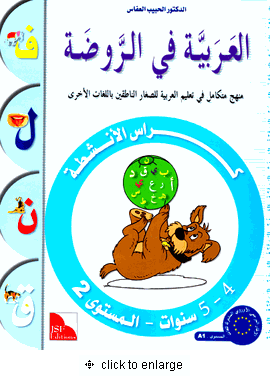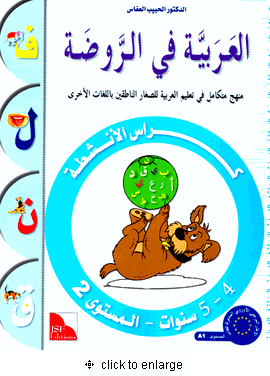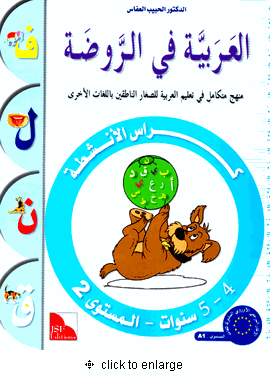I Love and Learn the Arabic Language Workbook: Level Pre-K 2
I Love and Learn the Arabic Language Workbook: Level Pre-K 2 is backordered and will ship as soon as it is back in stock.
Couldn't load pickup availability
Description
Description
The I Love Arabic Series comes to you from expert language teachers living in over 41 European countries. It focuses on teaching the Arabic language to non-native speakers, especially benefiting those who have little time to commit to Arabic throughout the weekdays, and makes learning easy by covering several educational levels: Kindergarten level for ages 3-5 years old and levels 1-6 for ages 6-11 years old. Three systematic divisions (sounds, words and syntactical structure, and conversational practices) enable the learner to generate language accurately in a variety of highly successful modern techniques. These focus sections present the Arabic language clearly and inclusively to meet the needs of Western learners. This curriculum develops fluency by communication, discovery, realization, and then application. It helps Arabic learners to deal confidently with Arabic culture, plus different types of reading and listening passages: Reading techniques are developed through the study of a wide selection of authentic reading passages, including classic Arabic without concentration on spoken dialect. Regular vocabulary exercises examine word building techniques. Careful balances of authentic and scripted listening materials build confidence whilst offering the ability to communicate with native Arabic speakers. A presentation of Arabic culture patterns help Western children to connect with their Arabic speaking peers in other parts of the world. Student Textbook: The student text is the first step of I Love Arabic Series (from 6 years old) and is supported by a comprehensive workbook, handwriting book, and teacher case. The text is comprised of 14 units discussing critical issues of a child’s world. Each unit is divided accordingly: Reading Dialogue: Simple and short passages comprising linguistic structures of sounds, vocabulary, expressions, and syntax structures, aim to facilitate learning by teaching the language process and communication. Reading Comprehension: Exercises aimed at determining the level of children’s comprehension for the meaning of dialogue expressions. Vocabulary: Vocabulary words are taken directly from reading dialogue. They are combined with graphics to further student understanding and sensory perception. Conversation: Conversational exercises encourage students to participate in classroom activities, apply reading material within dialogue, and ultimately become fluent speakers. Sounds: The Arabic language is introduced sound by sound to avoid difficulties that students may encounter while learning letters with similar appearance or sound. Workbook: The patterns of exercises include: Listening Comprehension: Exercises aimed at determining the level of children’s comprehension for new vocabularies through out determine the position of letter sound and circle it. Vocabulary: New vocabulary is listed to help with student memorization. Reading: to read the new letters, words then expressions gradually. Writing: Students practice writing letters and then joining them to become words. Illustrations help students to visualize words. llustrated Dictionary: An illustrated dictionary appears at the end of the workbook and includes word sets found throughout the lessons making memorization easy. Handwriting Book: Students practice writing Arabic letters, words, and then expressions. Teacher Case: Consists of: Teacher Guide: Tips on efficient teaching practices. Posters to be used as classroom visual aids Audio tapes.
I Love and Learn the Arabic Language Workbook: Level Pre-K 2 (From 4-5 years)
The I Love Arabic Series comes to you from expert language teachers living in over 41 European countries. It focuses on teaching the Arabic language to non-native speakers, especially benefiting those who have little time to commit to Arabic throughout the weekdays, and makes learning easy by covering several educational levels: Kindergarten level for ages 3-5 years old and levels 1-6 for ages 6-11 years old. Three systematic divisions (sounds, words and syntactical structure, and conversational practices) enable the learner to generate language accurately in a variety of highly successful modern techniques. These focus sections present the Arabic language clearly and inclusively to meet the needs of Western learners. This curriculum develops fluency by communication, discovery, realization, and then application. It helps Arabic learners to deal confidently with Arabic culture, plus different types of reading and listening passages: Reading techniques are developed through the study of a wide selection of authentic reading passages, including classic Arabic without concentration on spoken dialect. Regular vocabulary exercises examine word building techniques.
Delivery and Shipping
Delivery and Shipping
We endeavour to ship items as soon as the order arrives which is currently 1-2 working days.
For most regions and metro areas, shipping is $9.99
And, for any order of more than $100, shipping is FREE.
Payment & Security
Payment methods
Your payment information is processed securely. We do not store credit card details nor have access to your credit card information.



